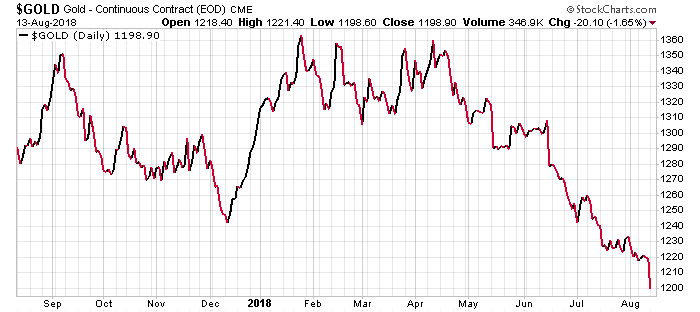In Times of Crisis, the Gold Price Moves Higher—This Is Why It Hasn’t…Just Yet
The gold price has not wavered from its downward course.
On August 13, the gold price fell below the $1,200-per-ounce price floor to stop just above $1,197 per ounce.

Chart courtesy of StockCharts.com
For over a year, as the chart above shows, the gold price had managed to stay afloat, averting a psychological drop.
Why Has the Gold Price Fallen so Sharply?
The explanation is that many investors are not thinking creatively. Rather, they all seem to be reacting in textbook ways. In other words, the main reason that the demand for gold has dampened has to do with the U.S. dollar.
The higher the dollar goes, the less appeal gold has. That’s what investors are thinking when it comes to the gold price.
And the dollar’s strength was on full display over the weekend. Instead of gold moving higher, as precious metals often did during episodes of international or national uncertainty, the dollar has risen in value instead.
In more predictable times, a financial crisis such as the recent one affecting Turkey—especially one with significant geopolitical repercussions—would have pushed the gold price higher.
But now it’s all about the U.S. dollar in the short term.
With gold having gained significant value over the past few months, Turkey’s troubles with its currency—the Turkish lira—have offset the safe-haven effect that crises usually create for gold.
As the theory goes, because gold is traded in dollars, investors suddenly discover—as if they didn’t know before—that it becomes too expensive. That then curbs demand for the precious metal.
In the context of the Turkish lira crisis, prospects suggest the dollar will continue to increase, further curbing the attraction of gold (under that logic). Therefore, many experts and financial managers will advise their clients to follow the herd, staying away from gold.











Leave A Comment